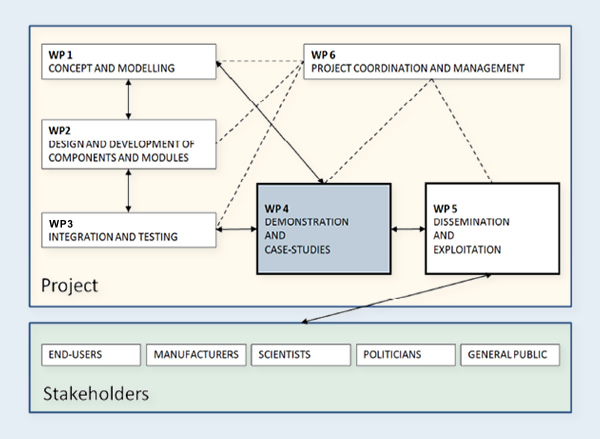SCIENTIFIC METHODOLOGY AND WORK PACKAGES
The work plan of our demonstration project is organised around six work packages which have been defined to achieve the project results and deliverables. The WPs will work partially in parallel so that feedbacks, loops and strategy patterns can be taken into account to guarantee that all aspects are integrated: WP1 Concept and modelling, WP2 Design and development of components and modules, WP3 Integration and testing, WP4 Demonstration of INAPRO systems, WP5 Dissemination and Exploitation, WP6 Project coordination and management.

INAPRO is mainly determined by the requirements and demands of industrial SMEs and end users. Especially manufacturing SMEs are strongly involved and will be the projects driving forces in research, development and demonstration. Scientific partners will be mainly responsible for experimental development, testing, monitoring and documentation. End-users are continually involved as consultants and advisors. Necessary corrections, adjustments or refinement solutions have to be worked out in close cooperation between all partners.
The first step of the project is to consider the capability of present aquaponic systems to cope with on-going and future water- related challenges. Gaps and opportunities in existing technologies concerning the whole water supply chain in aquaculture and horticulture will be identified. The application of integrated computer models that enable to simulate and optimise aquaponic systems with respect to water consumption, water quality, environmental impact, waste avoidance and nutrient recycling, management and maintenance efforts and costs is the core aspect of the project.
During the testing and validation phase, the INAPRO system will be integrated with cutting edges technologies. This will lead to an innovative solution for aquaponics that will be integrated and tested by manufacturers at the demonstration facilities.
The demonstration facilities represent the most important step towards commercialisation as they will prove the viability and economic profitability of the system in rural and urban scenarios. The potential of INAPRO innovative approach to water management – reduction of the overall water consumption, water reuse and improved waste water treatment with nutrients recovery- will also be demonstrated.
Energy demand and operational costs will be minimised through the integration of renewable energy and alternative water sources such as rainwater. The demand for freshwater will be minimised by the integration of two independent water recirculation systems, one for the fish part and one for the plants. The two systems will be connected by a one-way valve to transfer the water from the fish tanks to the plants. Moreover, the recuperation of the evapo-transpirated water from the plant section and its reintroduction to the system will cut the daily water use.
To inform, convince, win over and mobilise stakeholders from politics, science, industry and end-users from EU Member States and third countries, information events, training seminars, end- user workshops and other dissemination activities will be offered mainly at the sites of the demonstration objects. These events will spread and promote the INAPRO concept while demonstrating the practicalities of this innovative solution for aquaponics. Moreover, they will create new market opportunities for the European industry and SMEs. The Chinese partners will support to prove the viability of the INAPRO concept under the specific local conditions of Asia and will crucially facilitate access to Asian market.
